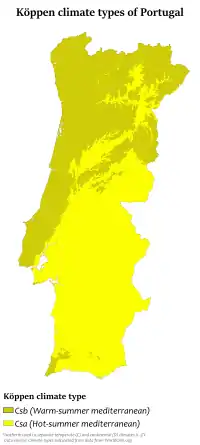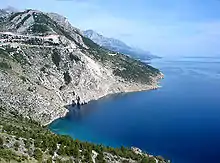Mediterranean climate
A Mediterranean climate /ˌmɛdɪtəˈreɪniən/ or dry summer climate is characterized by dry summers and mild, wet winters. The climate receives its name from the Mediterranean Basin, where this climate type is most common. Mediterranean climate zones are typically located along the western sides of continents, between roughly 30 and 45 degrees north and south of the equator. The main cause of Mediterranean, or dry summer climate, is the subtropical ridge which extends northwards during the summer and migrates south during the winter due to increasing north–south temperature differences.
.svg.png.webp)
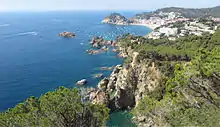
The resulting vegetation of Mediterranean climates are the garrigue or maquis in the Mediterranean Basin, the chaparral in California, the fynbos in South Africa, the mallee in Australia, and the matorral in Chile. Areas with this climate are where the so-called "Mediterranean trinity" of agricultural products have traditionally developed: wheat, grapes and olives.
Most historic cities of the Mediterranean Basin lie within Mediterranean climatic zones, including Algiers, Athens, Barcelona, Beirut, Casablanca, İzmir, Jerusalem, Lisbon, Marseille, Naples, Porto, Rome, Tunis, Valencia, and Valletta. Major cities with Mediterranean climates outside of the Mediterranean basin include Adelaide, Cape Town, Dushanbe, Los Angeles, Perth, Sacramento, San Diego, San Francisco, San Jose, CA, Santiago, Tashkent and Victoria.
Köppen climate classification
Under the Köppen climate classification, "hot dry-summer" climates (classified as Csa) and "cool dry-summer" climates (classified as Csb) are often referred to as "Mediterranean". Under the Köppen climate system, the first letter indicates the climate group (in this case temperate climates). Temperate climates or "C" zones have an average temperature above 0 °C (32 °F) (or −3 °C (27 °F)), but below 18 °C (64 °F), in their coolest months. The second letter indicates the precipitation pattern ("s" represents dry summers). Köppen has defined a dry summer month as a month with less than 30 mm (1.2 in) of precipitation and as a month within the high-sun months of April to September, in the case of the Northern Hemisphere and October to March, in the case of the Southern Hemisphere, and it also must contain exactly or less than one-third that of the wettest winter month. Some, however, use a 40 mm (1.6 in) level.[1][2] The third letter indicates the degree of summer heat: "a" represents an average temperature in the warmest month above 22 °C (72 °F), while "b" indicates the average temperature in the warmest month below 22 °C (72 °F).
Under the Köppen classification, dry-summer climates (Csa, Csb) usually occur on the western sides of continents. Csb zones in the Köppen system include areas normally not associated with Mediterranean climates but with Oceanic climates, such as much of the Pacific Northwest, much of southern Chile, parts of west-central Argentina, and parts of New Zealand.[3] Additional highland areas in the subtropics also meet Cs requirements, though they, too, are not normally associated with Mediterranean climates, as do a number of oceanic islands such as Madeira, the Juan Fernández Islands, the western part of the Canary Islands, and the eastern part of the Azores.
Under Trewartha's modified Köppen climate classification, the two major requirements for a Cs climate are revised. Under Trewartha's system, at least eight months must have average temperatures of 10 °C (50 °F) or higher (subtropical), and the average annual precipitation must not exceed 900 mm (35 in). Normally, climates that have eight or more months with a mean temperature over 10 °C (50 °F), are located in the southern portions of the temperate zone (latitudes 25 to 35 north and south), and have mean temperatures around 7 °C (45 °F) in the coldest months, and warmer than 22 °C (72 °F) in the warmest months. In the Trewartha climate classification system, the cooler summer Csb zones in the Köppen system become Do or temperate oceanic climate.
Under Holdridge life zones classification, the Mediterranean climates are either temperate or subtropical climates. They are frequently found within the Warm Temperate region as defined by Leslie Holdridge with a mean annual biotemperature between 12 °C (54 °F) and the frost line or critical temperature line, 16 to 18 °C (61 to 64 °F) (depending on locations in the world[4] but often "simplified" as 17 °C (63 °F) (= 2(log212+0;5) ≈ 16.97 °C (62.55 °F))[5]). Biotemperature is based on the growing season length and temperature. It is measured as the mean of all temperatures, with all temperatures below freezing and above 30 °C (86 °F) adjusted to 0 °C,[6] as plants are dormant at these temperatures. The frost line separates the warm temperate region from the subtropical region. It represents the dividing line between two major physiological groups of evolved plants. On the warmer side of the line, the majority of the plants are sensitive to low temperatures. They can be killed back by frosts as they have not evolved to withstand periods of cold. On the colder temperate side of the line, the total flora is adapted to survive periods of variable length of low temperatures, whether as seeds in the case of the annuals or as perennial plants which can withstand the cold. Only the warmest Mediterranean climates with a biotemperature between 16 °C (61 °F) to 18 °C (64 °F) and 24 °C (75 °F) are subtropical climates in Holdridge classification.
Precipitation
It [Chile] has six, months of winter, no more, and in them, except when there is a quarter moon, when it rains one or two days, all the other days have such beautiful suns...
During summer, regions of Mediterranean climate are strongly influenced by the subtropical ridge which keeps atmospheric conditions very dry with minimal cloud coverage. In some areas, such as coastal California, the cold current has a stabilizing effect on the surrounding air, further reducing the chances for rain, but often causing thick layers of marine fog that usually evaporates by mid-day. Similar to desert climates, in many Mediterranean climates there is a strong diurnal character to daily temperatures in the warm summer months due to strong heating during the day from sunlight and rapid cooling at night.
In winter, the subtropical ridge migrates towards the equator, making rainfall much more likely. As a result, areas with this climate receive almost all of their precipitation during their winter and spring seasons, and may go anywhere from 4 to 6 months during the summer and early fall without having any significant precipitation. In the lower latitudes, precipitation usually decreases in both the winter and summer. Toward the polar latitudes, total moisture usually increases; for instance, the Mediterranean climate in Southern Europe has more rain. The rainfall also tends to be more evenly distributed throughout the year in Southern Europe, while in places such as the Eastern Mediterranean, or in Southern California, the summer is nearly or completely dry. In places where evapotranspiration is higher, steppe climates tend to prevail, but still follow the basic pattern of the Mediterranean climate.
Temperature
The majority of the regions with Mediterranean climates have relatively mild winters and very warm summers. However, winter and summer temperatures can vary greatly between different regions with a Mediterranean climate. For instance, in the case of winters, Los Angeles experiences mild to warm temperatures in the winter, with frost and snowfall almost unknown, whereas Tashkent has cold winters with annual frosts and snowfall; or, to consider summer, Seville experiences rather high temperatures in that season. In contrast, San Francisco has cool summers with daily highs around 21 °C (70 °F) due to the continuous upwelling of cold subsurface waters along the coast. The special shielding from cold winds can also create a special Mediterranean microclimate, as in Barcola north of Trieste, which has been valued as a vacation spot and place of residence since ancient times.
Because most regions with a Mediterranean climate are near large bodies of water, temperatures are generally moderate, with a comparatively small range of temperatures between the winter low and summer high (although the daily range of temperature during the summer is large due to dry and clear conditions, except along the immediate coasts). Temperatures during winter only occasionally fall below the freezing point and snow is generally seldom seen. Summer temperatures can be cool to very hot, depending on distance from a large body of water, elevation, latitude, among other factors. Even in the warmest locations with a Mediterranean-type climate, however, temperatures usually do not reach the highest readings found in adjacent desert regions, because of cooling from water bodies, although strong winds from inland desert regions can sometimes boost summer temperatures, quickly increasing the risk of wildfires.
As in every climatologic domain, the highland locations of the Mediterranean domain can present cooler temperatures in winter than the lowland areas, temperatures which can sometimes prohibit the growth of typical Mediterranean plants. Some Spanish authors opt to use the term Continental Mediterranean Climate for some regions with lower temperature in winter than the coastal areas[7] (direct translation from Clima Mediterráneo Continentalizado), but most climate classifications (including Köppen's Cs zones) show no distinction.
Additionally, the temperature and rainfall pattern for a Csa or even a Csb climate can exist as a microclimate in some high-altitude locations adjacent to a rare tropical As (tropical savanna climate with dry summers, typically in a rainshadow region, as in Hawaii). These have a favourable climate, with mild wet winters and fairly warm, dry summers.
Mediterranean biome

The Mediterranean forests, woodlands, and scrub biome is closely associated with Mediterranean climate zones, as are unique freshwater communities. Particularly distinctive of the climate are sclerophyll shrublands, called maquis in the Mediterranean Basin, chaparral in California, matorral in Chile, fynbos in South Africa, and mallee and kwongan shrublands in Australia. Aquatic communities in Mediterranean climate regions are adapted to a yearly cycle in which abiotic (environmental) controls of stream populations and community structure dominate during floods, biotic components (e.g. competition and predation) controls become increasingly important as the discharge declines, and environmental controls regain dominance as environmental conditions become very harsh (i.e. hot and dry); as a result, these communities are well suited to recover from droughts, floods, and fires.[8] Aquatic organisms in these regions show distinct long-term patterns in structure and function,[9] and are also highly sensitive to the effects of climate change.[10][11]
Natural vegetation
The native vegetation of Mediterranean climate lands must be adapted to survive long, hot summer droughts and prolonged wet periods in winter. Mediterranean vegetation examples include the following:[12]
- Evergreen trees: bay laurel, pine, and cypress
- Deciduous trees: sycamore, oak, and buckeyes
- Fruit trees: olive, figs, walnuts and grapes
- Shrubs: rosemary, Erica, Banksia, and chamise
- Sub-shrubs: lavender, Halimium, and sagebrush
- Grasses: grassland types, Themeda triandra, bunchgrasses; sedges, and rushes
- Herbs: Achillea, Dietes, Helichrysum and Penstemon
Much native vegetation in Mediterranean climate area valleys have been cleared for agriculture. In places such as the Sacramento Valley and Oxnard Plain in California, draining marshes and estuaries combined with supplemental irrigation has led to a century of intensive agriculture. Much of the Overberg in the southern Cape of South Africa, once covered with renosterveld, has likewise been largely converted to agriculture, mainly wheat. In hillside and mountainous areas, away from urban sprawl, ecosystems and habitats of native vegetation are more sustained.
The fynbos vegetation in the South-western Cape in South Africa is famed for its high floral diversity, and includes such plant types as members of the Restionaceae, Ericas (Heaths) and Proteas. Representatives of the Proteaceae also grow in Australia, such as Banksias. The palette of California native plants is also renowned for its species and cultivar diversity.
Hot-summer Mediterranean climate
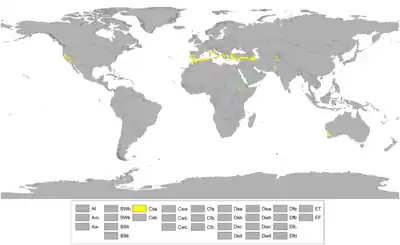
This subtype of the Mediterranean climate (Csa) is the most common form of the Mediterranean climate, therefore it is also known as a "typical Mediterranean climate". As stated earlier, regions with this form of a Mediterranean climate experience average monthly temperatures in excess of 22.0 °C (71.6 °F) during its warmest month and an average in the coldest month between 18 and −3 °C (64 and 27 °F) or, in some applications, between 18 and 0 °C (64 and 32 °F). Also, at least four months must average above 10 °C (50 °F). Regions with this form of the Mediterranean climate typically experience hot, sometimes very hot and dry summers and mild, wet winters. In a number of instances, summers here can closely resemble summers seen in arid and semi-arid climates. However, high temperatures during summers are generally not quite as high as those in arid or semiarid climates due to the presence of a large body of water. All areas with this subtype have wet winters. However, some areas with a hot Mediterranean subtype can actually experience very chilly winters, with occasional snowfall.
Csa climates are mainly found around the Mediterranean Sea, southwestern Australia, southwestern South Africa, sections of Central Asia, northern sections of Iran and Iraq, the interior of northern California west of the Sierra Nevada, and inland areas of southern Oregon west of the Cascade Mountains. Southern California's coasts also experience hot summers due to the shielding effect of the Channel Islands. However, unshielded areas of that coastline can have warm-summer Mediterranean climates with hot-summer areas just a few kilometres inland.
| Valencia, Spain | ||||||||||||||||||||||||||||||||||||||||||||||||||||||||||||
|---|---|---|---|---|---|---|---|---|---|---|---|---|---|---|---|---|---|---|---|---|---|---|---|---|---|---|---|---|---|---|---|---|---|---|---|---|---|---|---|---|---|---|---|---|---|---|---|---|---|---|---|---|---|---|---|---|---|---|---|---|
| Climate chart (explanation) | ||||||||||||||||||||||||||||||||||||||||||||||||||||||||||||
| ||||||||||||||||||||||||||||||||||||||||||||||||||||||||||||
| ||||||||||||||||||||||||||||||||||||||||||||||||||||||||||||
| Los Angeles, United States | ||||||||||||||||||||||||||||||||||||||||||||||||||||||||||||
|---|---|---|---|---|---|---|---|---|---|---|---|---|---|---|---|---|---|---|---|---|---|---|---|---|---|---|---|---|---|---|---|---|---|---|---|---|---|---|---|---|---|---|---|---|---|---|---|---|---|---|---|---|---|---|---|---|---|---|---|---|
| Climate chart (explanation) | ||||||||||||||||||||||||||||||||||||||||||||||||||||||||||||
| ||||||||||||||||||||||||||||||||||||||||||||||||||||||||||||
| Perth, Australia | ||||||||||||||||||||||||||||||||||||||||||||||||||||||||||||
|---|---|---|---|---|---|---|---|---|---|---|---|---|---|---|---|---|---|---|---|---|---|---|---|---|---|---|---|---|---|---|---|---|---|---|---|---|---|---|---|---|---|---|---|---|---|---|---|---|---|---|---|---|---|---|---|---|---|---|---|---|
| Climate chart (explanation) | ||||||||||||||||||||||||||||||||||||||||||||||||||||||||||||
| ||||||||||||||||||||||||||||||||||||||||||||||||||||||||||||
| ||||||||||||||||||||||||||||||||||||||||||||||||||||||||||||
Warm-summer Mediterranean climate
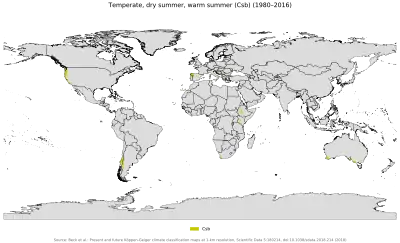
Occasionally also termed "Cool-summer Mediterranean climate", this subtype of the Mediterranean climate (Csb) is a less common form of the Mediterranean climate.
As stated earlier, regions with this subtype of the Mediterranean climate experience warm (but not hot) and dry summers, with no average monthly temperatures above 22 °C (72 °F) during its warmest month and an average in the coldest month between 18 and −3 °C (64 and 27 °F) or, in some applications, between 18 and 0 °C (64 and 32 °F).
Also, at least four months must average above 10 °C (50 °F).
Cool ocean currents and upwelling are often the reason for this cooler type of Mediterranean climate. This is why it rarely occurs on the Mediterranean Sea shores, as it is a warm sea, from 3 to 6°C above the theoric value according to Jean Demangeot.[15]
The other main reason of this cooler type is the altitude. For instance Menton on the French coast has a Csa climate while Castellar, Alpes-Maritimes, the adjacent town just north of Menton, with an altitude between 100 m and 1,382 m, has a Csb climate.[16]
Winters are rainy and can be mild to chilly. In a few instances, snow can fall on these areas.
Precipitation occurs in the colder seasons, but there are a number of clear sunny days even during the wetter seasons.
Csb climates are found in northwestern Iberian Peninsula (namely Galicia and the Norte region and west coast of Portugal), in coastal California, in the Pacific Northwest (namely western Washington, western Oregon and southern portions of Vancouver Island in British Columbia),[17][18][19][20][21] in central Chile, in parts of southern Australia and in sections of southwestern South Africa.
| Porto, Portugal | ||||||||||||||||||||||||||||||||||||||||||||||||||||||||||||
|---|---|---|---|---|---|---|---|---|---|---|---|---|---|---|---|---|---|---|---|---|---|---|---|---|---|---|---|---|---|---|---|---|---|---|---|---|---|---|---|---|---|---|---|---|---|---|---|---|---|---|---|---|---|---|---|---|---|---|---|---|
| Climate chart (explanation) | ||||||||||||||||||||||||||||||||||||||||||||||||||||||||||||
| ||||||||||||||||||||||||||||||||||||||||||||||||||||||||||||
| ||||||||||||||||||||||||||||||||||||||||||||||||||||||||||||
| Victoria, Canada | ||||||||||||||||||||||||||||||||||||||||||||||||||||||||||||
|---|---|---|---|---|---|---|---|---|---|---|---|---|---|---|---|---|---|---|---|---|---|---|---|---|---|---|---|---|---|---|---|---|---|---|---|---|---|---|---|---|---|---|---|---|---|---|---|---|---|---|---|---|---|---|---|---|---|---|---|---|
| Climate chart (explanation) | ||||||||||||||||||||||||||||||||||||||||||||||||||||||||||||
| ||||||||||||||||||||||||||||||||||||||||||||||||||||||||||||
| ||||||||||||||||||||||||||||||||||||||||||||||||||||||||||||
| Cape Town, South Africa | ||||||||||||||||||||||||||||||||||||||||||||||||||||||||||||
|---|---|---|---|---|---|---|---|---|---|---|---|---|---|---|---|---|---|---|---|---|---|---|---|---|---|---|---|---|---|---|---|---|---|---|---|---|---|---|---|---|---|---|---|---|---|---|---|---|---|---|---|---|---|---|---|---|---|---|---|---|
| Climate chart (explanation) | ||||||||||||||||||||||||||||||||||||||||||||||||||||||||||||
| ||||||||||||||||||||||||||||||||||||||||||||||||||||||||||||
| ||||||||||||||||||||||||||||||||||||||||||||||||||||||||||||
Cold-summer Mediterranean climate
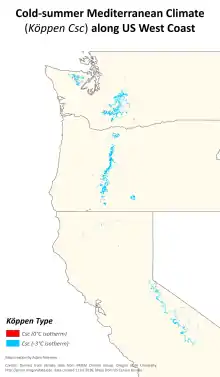
The cold-summer subtype of the Mediterranean climate (Csc) is rare and predominately found at scattered high-altitude locations along the west coasts of North and South America. This type is characterized by cool summers, with fewer than four months with a mean temperature at or above 10 °C (50 °F), as well as with mild winters, with no winter month having a mean temperature below 0 °C (32 °F) (or −3 °C [27 °F]), depending on the isotherm used). Regions with this climate are influenced by the dry-summer trend that extends considerably poleward along the west coast of the Americas, as well as the moderating influences of high altitude and relative proximity to the Pacific Ocean.
In North America, areas with Csc climate can be found in the Olympic, Cascade, Klamath, and Sierra Nevada ranges in Washington, Oregon and California. These locations are found at high altitude nearby lower altitude regions characterized by a warm-summer Mediterranean climate (Csb) or hot-summer Mediterranean climate (Csa). A rare instance of this climate occurs in the tropics, on Haleakalā Summit in Hawaii.
In South America, Csc regions can be found along the Andes in Chile and Argentina. The town of Balmaceda is one of the few towns confirmed to have this climate.
Small areas with a Csc climate can be found at high elevations in Corsica.
In Europe, the Norwegian Island of røst above the Arctic circle has a Csc climate and is known as a climatic anomaly due to abnormally warm temperatures compared to its northerly latitude.
| Balmaceda, Chile | ||||||||||||||||||||||||||||||||||||||||||||||||||||||||||||
|---|---|---|---|---|---|---|---|---|---|---|---|---|---|---|---|---|---|---|---|---|---|---|---|---|---|---|---|---|---|---|---|---|---|---|---|---|---|---|---|---|---|---|---|---|---|---|---|---|---|---|---|---|---|---|---|---|---|---|---|---|
| Climate chart (explanation) | ||||||||||||||||||||||||||||||||||||||||||||||||||||||||||||
| ||||||||||||||||||||||||||||||||||||||||||||||||||||||||||||
| ||||||||||||||||||||||||||||||||||||||||||||||||||||||||||||
| Haleakala Summit, United States | ||||||||||||||||||||||||||||||||||||||||||||||||||||||||||||
|---|---|---|---|---|---|---|---|---|---|---|---|---|---|---|---|---|---|---|---|---|---|---|---|---|---|---|---|---|---|---|---|---|---|---|---|---|---|---|---|---|---|---|---|---|---|---|---|---|---|---|---|---|---|---|---|---|---|---|---|---|
| Climate chart (explanation) | ||||||||||||||||||||||||||||||||||||||||||||||||||||||||||||
| ||||||||||||||||||||||||||||||||||||||||||||||||||||||||||||
| ||||||||||||||||||||||||||||||||||||||||||||||||||||||||||||
References
- Kottek, Markus; Grieser, Jürgen; Beck, Christoph; Rudolf, Bruno; Rube, Franz (June 2006). "World Map of the Köppen-Geiger climate classification updated" (PDF). Meteorologische Zeitschrift. 15 (3): 259–263. Bibcode:2006MetZe..15..259K. doi:10.1127/0941-2948/2006/0130. Archived (PDF) from the original on 12 April 2019. Retrieved 27 February 2011.
- Peel, M. C.; Finlayson, B. L.; McMahon, T. A. (2007). "Updated world map of the Köppen-Geiger climate classification" (PDF). Hydrology and Earth System Sciences. 4 (2): 439–473. doi:10.5194/hessd-4-439-2007. Archived (PDF) from the original on 28 August 2019. Retrieved 27 February 2011.
- Peel, M. C.; Finlayson, B. L.; McMahon, T. A. (2007). "Updated world map of the Köppen-Geiger climate classification". Hydrology and Earth System Sciences. 11 (5): 1633–1644. Bibcode:2007HESS...11.1633P. doi:10.5194/hess-11-1633-2007. Archived from the original on 10 February 2017. Retrieved 27 February 2011.
- "LIFE ZONE ECOLOGY by L. R. Holdridge" (PDF). Archived (PDF) from the original on 12 July 2018. Retrieved 12 February 2020.
- The climate of Carpathian Region in the 20th century based on the original and modified Holdridge life zone system
- Lugo, A. E. (1999). "The Holdridge life zones of the conterminous United States in relation to ecosystem mapping". Journal of Biogeography. 26 (5): 1025–1038. doi:10.1046/j.1365-2699.1999.00329.x. Archived (PDF) from the original on 27 May 2015. Retrieved 27 May 2015.
- "España a Través de los Mapas". www.ign.es. Archived from the original on 26 August 2010. Retrieved 6 October 2010.
- Gasith, A. and V.H. Resh (1999). "Streams in mediterranean Climate Regions: Abiotic Influences and Biotic Responses to Predictable Seasonal Events". Annu. Rev. Ecol. Syst. 30: 51–81. doi:10.1146/annurev.ecolsys.30.1.51.
- Resh, V.H.; L.A. Bêche; J.E. Lawrence; R.D. Mazor; E.P. McElravy; A.H. Purcell; S.M. Carlson (2013). "Long-term Population and Community Patterns of Benthic Macroinvertebrates and Fishes in Northern California Mediterranean-climate Streams". Journal of the North American Benthological Society. 719: 93–118. doi:10.1007/s10750-012-1373-9. S2CID 186919.
- Lawrence, J.E.; K.B. Lunde; R.D. Mazor; L.A. Bêche; E.P. McElravy; V.H. Resh (2010). "Long-Term Macroinvertebrate Responses to Climate Change: Implications for Biological Assessment in Mediterranean-Climate Streams". Journal of the North American Benthological Society. 29 (4): 1424–1440. doi:10.1899/09-178.1. S2CID 84679634.
- Filipe, A.F.; J.E. Lawrence; N. Bonada (November 2013). "Vulnerability of Biota in Mediterranean Streams to Climate Change: A Synthesis of Ecological Responses and Conservation Challenges". Hydrobiologia. 719: 331–351. doi:10.1007/s10750-012-1244-4. hdl:2445/48186. S2CID 17658477.
- Dallman, Peter (1998). Plant Life in the World's Mediterranean Climates. Berkeley, CA: University of California Press. ISBN 9780520208094. Archived from the original on 28 May 2010. Retrieved 26 September 2012.
- Meteorología, Agencia Estatal de. "Valores climatológicos normales: Valencia - Agencia Estatal de Meteorología - AEMET. Gobierno de España". www.aemet.es.
- "Perth Monthly climate statistics". Australia Bureau of Meteorology. Archived from the original on 10 March 2011. Retrieved 2 August 2010.
- "Archived copy" (PDF). Archived (PDF) from the original on 28 July 2018. Retrieved 28 March 2020.CS1 maint: archived copy as title (link)
- "Archived copy". Archived from the original on 28 March 2020. Retrieved 28 March 2020.CS1 maint: archived copy as title (link)
- "The Warm Land: 5 must-do activities at this hidden B.C. gem". Archived from the original on 21 February 2019. Retrieved 21 February 2019.
- "Explore Southern Vancouver Island's small communities". 8 July 2016. Archived from the original on 21 February 2019. Retrieved 21 February 2019.
- "mediterranean+climate" Nature Canada. 1994.
- (1849-1914), Canadian Institute; Institute, Royal Canadian (1949). "mediterranean+climate" Transactions of the Royal Canadian Institute.CS1 maint: numeric names: authors list (link)
- Communications, Emmis (June 1980). "mediterranean+climate"&pg=PA36 Cincinnati Magazine.
- "Monthly Averages for Porto, Portugal". Instituto de Meteorologia. Archived from the original on 26 February 2012. Retrieved 2 August 2010.
- "Victoria Gonzales HTS, British Columbia". Canadian Climate Normals 1971–2000 (in English and French). Environment Canada. 19 January 2011. Archived from the original on 17 May 2013. Retrieved 15 February 2013.
- "Weather Information for Cape Town". World Weather Information Service. Archived from the original on 26 April 2010. Retrieved 2 August 2010.
- "Estadistica Climatologica Tomo III (pg 319-343)" (PDF). Dirección General de Aeronáutica Civil. Archived from the original (PDF) on 17 April 2012. Retrieved 15 January 2013.
- "Datos climatológicos Chile Sur". Atmosfera.cl. Archived from the original on 9 December 2012.
- "Seasonal Temperature and Precipitation Information". Western Regional Climate Center. Archived from the original on 4 November 2016. Retrieved 3 November 2013.
External links
![]() Media related to Mediterranean climate at Wikimedia Commons
Media related to Mediterranean climate at Wikimedia Commons
